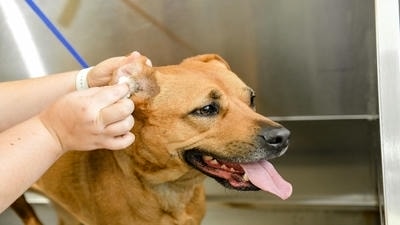
Yeast infections are a common yet often overlooked health issue in pets. Caused by an overgrowth of yeast (typically Malassezia or Candida species), these infections can cause discomfort, itching, and even serious complications if left untreated. While yeast is naturally present on the skin and in the ears of pets, certain conditions can lead to its overgrowth, resulting in infection.
Yeast infections occur when there is an overgrowth of yeast on the skin, in the ears, or in other moist areas of the body. The most common types of yeast that affect pets are Malassezia and Candida.
Yeast infections can cause significant discomfort, including itching, redness, and inflammation. If left untreated, they can lead to secondary infections, chronic skin issues, and a reduced quality of life for your pet.

Yeast infections in the ears (otitis externa) are particularly common in dogs and cats. Symptoms include itching, redness, and a foul odor.
Yeast infections on the skin often occur in moist areas, such as between the toes, under the armpits, or in skin folds. Signs include redness, itching, and greasy or scaly patches.
Paws are a common site for yeast infections, especially in dogs. Persistent licking or chewing of the paws is a telltale sign.
Yeast infections can also occur in the genital area, causing itching, redness, and discomfort.

Your veterinarian will perform a thorough physical examination to assess the affected areas and look for signs of yeast overgrowth.

Diluted apple cider vinegar can be used as a natural antifungal rinse for the skin or ears. Mix one part vinegar with one part water and apply with a cloth or cotton ball.
Coconut oil has antifungal properties and can be applied topically to soothe irritated skin and reduce yeast growth.
Plain, unsweetened yogurt with live cultures can help restore healthy bacteria in your pet’s gut and skin.
Dogs, especially those with floppy ears or skin folds (e.g., Bulldogs, Basset Hounds), are particularly prone to yeast infections. Regular grooming and ear care are essential.
Cats can also develop yeast infections, often in the ears or skin. Watch for excessive scratching, head shaking, or changes in behavior.
Rabbits, guinea pigs, and other small animals can develop yeast infections in the ears or genital area. Keep their enclosures clean and dry.
Fact: Yeast infections are not contagious between pets or humans. However, the underlying conditions that contribute to yeast overgrowth (e.g., allergies) may affect multiple pets.
Fact: While yeast infections often cause a distinct odor, not all pets will have this symptom. Look for other signs, such as itching or redness.
Fact: Yeast infections typically require treatment to resolve. Without intervention, they can worsen and lead to complications.
If your pet shows signs of a yeast infection, such as persistent itching, redness, or odor, consult your veterinarian for a proper diagnosis and treatment plan. Early intervention can prevent the infection from spreading or becoming chronic.
Yeast infections can cause significant discomfort for your pet, but with proper identification, treatment, and prevention, you can help keep them healthy and happy. Regular grooming, a balanced diet, and attentive care are key to reducing the risk of yeast overgrowth. If you suspect your pet has a yeast infection, seek veterinary advice promptly to ensure they receive the best possible care. By staying vigilant and proactive, you can protect your furry friend from the discomfort of yeast infections and ensure their well-being.